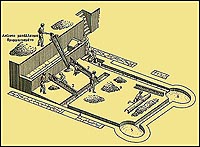On a rough calculation, of the ninety
thousand slaves in Hellas in the fifth century, twenty
thousand adult males were working in the various mines of
the country. Of the remaining seventy thousand,
thirty-five thousand were adult males, twenty-five
thousand were adult females, and ten thousand were
children. |
Slaves began to be used in the Laurion mines after
the 520s B.C. To judge from Thucydides (7.27),
there were during the fifth century, when production peaked,
about twenty thousand slaves working in the Laurion
mines. The Athenian state kept a firm hold on mining
rights. The actual working of the mines, however, was in
the hands of private persons, the lessees, who used
slaves to do the manual labour of digging, carrying,
sorting, collecting, cleaning, and casting the silver. |
 |



